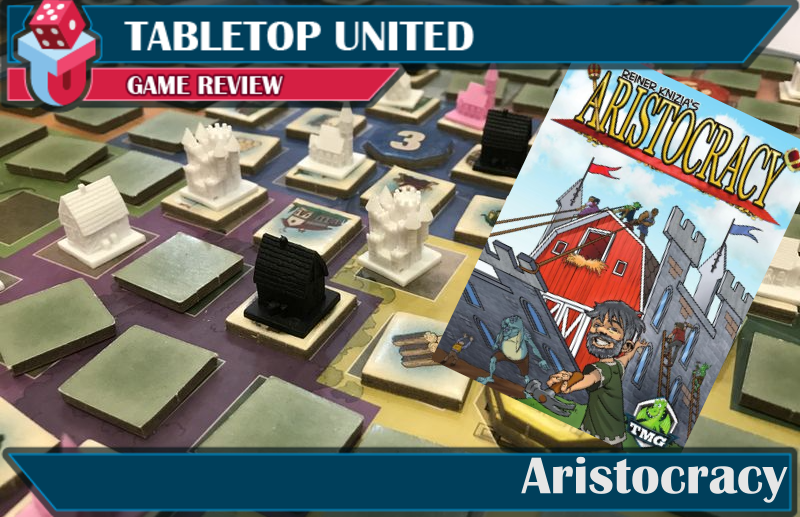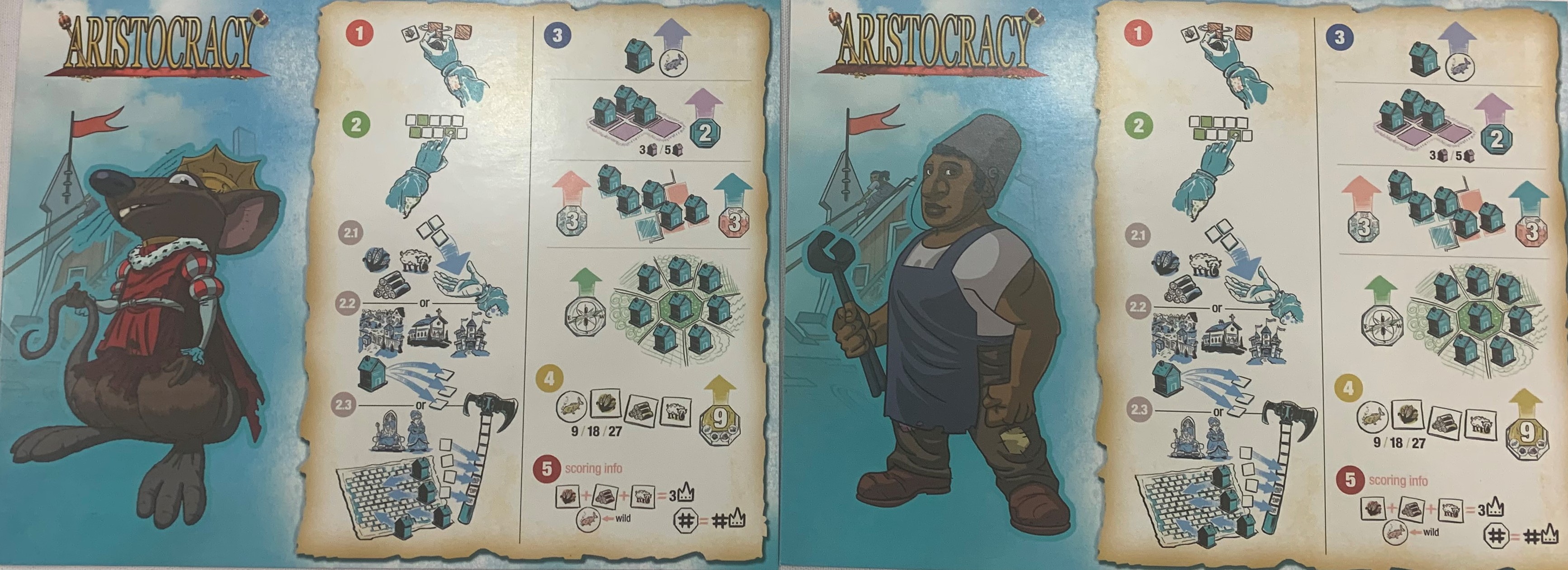
Aristocracy
Designer: Reiner Knizia
Artist: Robert Gonzales and Andy Jewett
Publisher: Tasty Minstrel Games
Year Published: 2019
No. of Players: 2–4
Ages: 14+
Playing Time: 45 minutes
Main mechanic / Theme: exposing locations, set building, area/majority influence
The time is now to make your bid for the throne.
Find more info on BoardGameGeek.com
Overview:
The throne is empty, and the members of the aristocracy are each making their bid to occupy that seat. You must secure resources and build within and between the regions of the kingdom to secure the position for yourself.

Gameplay and Mechanisms:
Aristocracy scores points by controlling locations to connect the different regions of the board and by gathering resources. Each game starts with the identification of what is located on each space on the board hidden. The tiles that are used to cover the spaces have a set amount to choose from, but the final number of each of the resources, buildings, king, and queen tiles vary due to extras and are randomly placed face down on each spot.
The player cards provide easy reference to how the points are scored. The depictions of the characters on the cards do not influence the game.
In turn order, players turn over a set number of tiles and then must decide what their remaining action is based on the tiles that are exposed. This includes any tiles that have already been turned over by previously. This provided a nice balance for the starting of the game to limit the first turn advantage.
Players choose a resource, building, or one of the types of royalty tiles to complete their turn. Choosing resources allows you to collect that type and place them in sets in front of you. There are two types of resource sets, one of each type and nine of any combination.
When choosing building, you pick a particular style and place building markers on all the same type. The king and queen tiles are moved to their individual tracks when they are chosen. For each of these markers removed from the playing field the player plays a building in an empty space.
Buildings score points by having groupings in one of the regions of the gameboard, for bridging between two regions, and by having one in each region (or two sets, etc.). The placing of buildings by using the maneuver using the royalty works to fill in the gaps. Placing building is also the only way to collect the resource of fish.
Each of the tracks for the king and queen also determines the end of the game. When both reach the point on the track indicating the number of players, the game ends. This also gives the strategy of determining if you want to end the game or score more points with a different action. For our game this happened with two of us because we were pretty sure we were lagging on the score. When we finished, we ended up with only a four-point difference between first and last.
Theme, Artwork and Illustration, Graphic Design and Layout (optional)
Aristocracy was designed by Reiner Knizia. Knizia has been designing games for several decades now and has over 25 awards for games he has designed. Aristocracy is an example of why he has done so well over the years. Here is a game with easy to learn rules with multiple paths on each turn to choose from.
Each game has a different pattern of tiles and allows for replay-ability with different choices needing to be made leading to different games every time.
The artwork in Aristocracy is by Robert Gonzales and Andy Jewett. With the cover as an example, you are immediately moved into a game that isn’t taking itself too seriously. Even with the level of strategy, you can play Aristocracy in a social setting. It is more about how you are scoring and even though you can play to block, that would probably work against you in the end.
Inclusivity and Accessibility:
The tiles are flatter and require some finger dexterity to pick them up and turn them over. They are also a little smaller and did require a closer look at times for those of us whose eyes are getting older.
Final Thoughts:
We had a three-player game of Aristocracy. One of the main reasons for our selection was because of past experiences with Tiny Minstrel Games. Seeing the name of who made the game foreshadowed the fact that we made a good decision. We all enjoyed the ease of learning, the play, and the variability.
Our play, which included learning the rules, was still right around the expected time of play.
I would recommend Aristocracy for players who like strategy games of planning how to build where you want to be. This isn’t a strategy of eliminating another player from the board.
About the Author
Daniel Yocom does geeky things at night because his day job won't let him. This dates back to the 1960s through games, books, movies, and stranger things better shared in small groups. He's written hundreds of articles about these topics for his own blog, other websites, and magazines after extensive research along with short stories. His research includes attending conventions, sharing on panels and presentations, and road-tripping with his wife. Join him at guildmastergaming.com.

